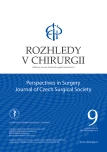Percutaneous endoscopic cecostomy in the treatment of recurrent colonic pseudo-obstruction − a case report of the first procedure in the Czech Republic
Authors:
P. Vaněk 1,2; Přemysl Falt 1,2,3; O. Urban 1,2
Authors‘ workplace:
II. interní klinika − gastroenterologická a geriatrická, Fakultní nemocnice Olomouc
1; Lékařská fakulta Univerzity Palackého v Olomouci
2; Lékařská fakulta Univerzity Karlovy v Hradci Králové
3
Published in:
Rozhl. Chir., 2019, roč. 98, č. 9, s. 375-378.
Category:
Case Report
doi:
https://doi.org/10.33699/PIS.2019.98.9.375–378
Overview
We present the case of an 89-year-old polymorbid female patient with recurrent acute colonic pseudo-obstruction who was treated by performing percutaneous endoscopic cecostomy as the first procedure of its kind in the Czech Republic. The patient presented repeatedly with ileous conditions without evidence of an organic cause. Surgical colostomy was proposed with a possibility of subtotal colectomy as an ultimum refugium due to an insufficient effect of maximum conservative management and a need for repeated endoscopic decompression. In this particular patient, however, any kind of surgical intervention posed a major risk and was eventually abandoned. Finally, percutaneous endoscopic cecostomy was proposed as an alternative to resolve the situation. The procedure was carried out without complications and with an immediate effect. The patient has been free of the symptomatology of intestinal obstruction in the long term having the option of intermittent intestinal decompression as needed.
Keywords:
percutaneous endoscopic cecostomy – colostomy – colonic pseudo-obstruction – Ogilvie’s syndrome
Sources
- Vanek VW, Al-Salti M. Acute pseudo-obstruction of the colon (Ogilvie‘s syndrome). An analysis of 400 cases. Dis Colon Rectum. 1986;29 : 203. doi: 10.1007/bf02555027.
- Ennis O, Feroz A, Stephenson B. Percutaneous endoscopic colostomy: An alternative treatment of acute colonic pseudoobstruction. Colorectal Dis. 2001;3 : 205–8. doi:10.1046/j.1463-1318.2001.00234.x.
- De Giorgio R, Knowles CH. Acute colonic pseudo-obstruction. Br J Surg. 2009;96 : 229. doi:10.1002/bjs.6480.
- Tun G, Bullas D, Bannaga A, et al. Percutaneous endoscopic colostomy: a useful technique when surgery is not an option. Ann Gastroenterol. 2016;29 : 477–80. doi:10.20524/aog.2016.0058.
- Koundouris C, Thivaios I, Chrysoulas G, et al. Percutaneous endoscopic colostomy/caecostomy − a minimally invasive approach to certain colonic disorders: Report of five cases and review of the literature. Hellenic J Surg. 2016;88 : 93. doi:10.1007/s13126-016-0293-y.
- Baraza W, Brown S, McAlindon M, et al. Prospective analysis of percutaneous endoscopic colostomy at a tertiary referral centre. Br J Surg. 2007;94 : 1415–20. doi:10.1002/bjs.5858.
- Ponsky J L, Aszodi A, Perse D. Percutaneous endoscopic cecostomy: a new approach to nonobstructive colonic dilation. Gastrointest Endosc. 1986;32 : 108–11. doi: 10.1016/s0016-5107(86)71770-7.
- National Institute of Clinical Excellence; Interventional procedure guidance (IPG) Percutaneous endoscopic colostomy [Internet] 2006. Available from: www.nice.org.uk/IPG161.
- Al-Alawi IK. Percutaneous endoscopic colostomy: A new technique for the treatment of recurrent sigmoid volvulus. Saudi J Gastroenterol. 2010;16 : 120−1. doi:10.4103/1319-3767.61241.
- Coron E. Should we recommend PEC and when? Endosc Int Open 2016;4:E742–E743. doi:10.1055/s-0042-105513.
- Bertolini D, De Saussure P, Chilcott M, et al. Severe delayed complication after percutaneous endoscopic colostomy for chronic intestinal pseudo-obstruction: A case report and review of the literature. World J Gastroenterol. 2007;13 : 2255–7. doi:10.3748/wjg.v13.i15.2255.
Labels
Surgery Orthopaedics Trauma surgeryArticle was published in
Perspectives in Surgery

2019 Issue 9
Most read in this issue
- Foreign body ingestion in children
- Phyllodes tumours – a retrospective review of 83 clinical cases
- ERAS in colorectal surgery – neglected preadmission items
- Percutaneous endoscopic cecostomy in the treatment of recurrent colonic pseudo-obstruction − a case report of the first procedure in the Czech Republic
